Hospitality Operations: Food Production Systems, Menu Planning, and Sustainable Strategies
VerifiedAdded on 2023/06/15
|11
|3071
|418
AI Summary
This report explores the various types of food production systems and food and beverage service methods available in the hospitality industry. It also discusses menu planning considerations and constraints, and provides sustainable strategies for competitive markets. The report focuses on the Lowry hotel, a luxury hotel in the United Kingdom.
Contribute Materials
Your contribution can guide someone’s learning journey. Share your
documents today.

Hospitality Operations
Secure Best Marks with AI Grader
Need help grading? Try our AI Grader for instant feedback on your assignments.

Table of Contents
INTRODUCTION...........................................................................................................................3
MAIN BODY..................................................................................................................................3
1.Different type of food production systems available in the hotel for the position of Food &
Beverage Management Trainee...................................................................................................3
2.Various types of food and beverage service methods available in the food and beverage
outlets within the hotel.................................................................................................................5
3. Different menu planning considerations and constraints.........................................................6
4.Sustainable menu planning to be in the competitive market....................................................8
CONCLUSION................................................................................................................................9
REFRENCES...................................................................................................................................9
Books and Journal........................................................................................................................9
INTRODUCTION...........................................................................................................................3
MAIN BODY..................................................................................................................................3
1.Different type of food production systems available in the hotel for the position of Food &
Beverage Management Trainee...................................................................................................3
2.Various types of food and beverage service methods available in the food and beverage
outlets within the hotel.................................................................................................................5
3. Different menu planning considerations and constraints.........................................................6
4.Sustainable menu planning to be in the competitive market....................................................8
CONCLUSION................................................................................................................................9
REFRENCES...................................................................................................................................9
Books and Journal........................................................................................................................9
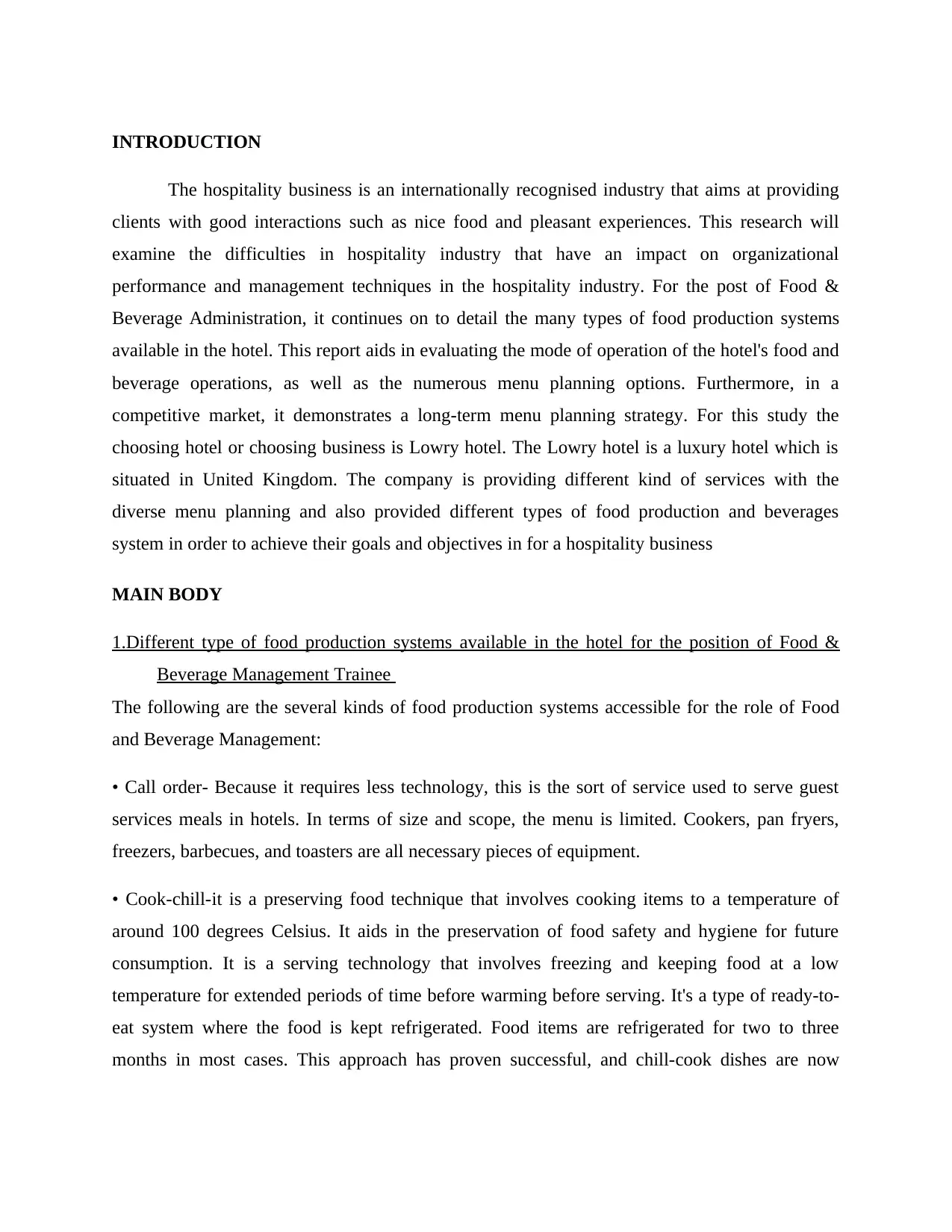
INTRODUCTION
The hospitality business is an internationally recognised industry that aims at providing
clients with good interactions such as nice food and pleasant experiences. This research will
examine the difficulties in hospitality industry that have an impact on organizational
performance and management techniques in the hospitality industry. For the post of Food &
Beverage Administration, it continues on to detail the many types of food production systems
available in the hotel. This report aids in evaluating the mode of operation of the hotel's food and
beverage operations, as well as the numerous menu planning options. Furthermore, in a
competitive market, it demonstrates a long-term menu planning strategy. For this study the
choosing hotel or choosing business is Lowry hotel. The Lowry hotel is a luxury hotel which is
situated in United Kingdom. The company is providing different kind of services with the
diverse menu planning and also provided different types of food production and beverages
system in order to achieve their goals and objectives in for a hospitality business
MAIN BODY
1.Different type of food production systems available in the hotel for the position of Food &
Beverage Management Trainee
The following are the several kinds of food production systems accessible for the role of Food
and Beverage Management:
• Call order- Because it requires less technology, this is the sort of service used to serve guest
services meals in hotels. In terms of size and scope, the menu is limited. Cookers, pan fryers,
freezers, barbecues, and toasters are all necessary pieces of equipment.
• Cook-chill-it is a preserving food technique that involves cooking items to a temperature of
around 100 degrees Celsius. It aids in the preservation of food safety and hygiene for future
consumption. It is a serving technology that involves freezing and keeping food at a low
temperature for extended periods of time before warming before serving. It's a type of ready-to-
eat system where the food is kept refrigerated. Food items are refrigerated for two to three
months in most cases. This approach has proven successful, and chill-cook dishes are now
The hospitality business is an internationally recognised industry that aims at providing
clients with good interactions such as nice food and pleasant experiences. This research will
examine the difficulties in hospitality industry that have an impact on organizational
performance and management techniques in the hospitality industry. For the post of Food &
Beverage Administration, it continues on to detail the many types of food production systems
available in the hotel. This report aids in evaluating the mode of operation of the hotel's food and
beverage operations, as well as the numerous menu planning options. Furthermore, in a
competitive market, it demonstrates a long-term menu planning strategy. For this study the
choosing hotel or choosing business is Lowry hotel. The Lowry hotel is a luxury hotel which is
situated in United Kingdom. The company is providing different kind of services with the
diverse menu planning and also provided different types of food production and beverages
system in order to achieve their goals and objectives in for a hospitality business
MAIN BODY
1.Different type of food production systems available in the hotel for the position of Food &
Beverage Management Trainee
The following are the several kinds of food production systems accessible for the role of Food
and Beverage Management:
• Call order- Because it requires less technology, this is the sort of service used to serve guest
services meals in hotels. In terms of size and scope, the menu is limited. Cookers, pan fryers,
freezers, barbecues, and toasters are all necessary pieces of equipment.
• Cook-chill-it is a preserving food technique that involves cooking items to a temperature of
around 100 degrees Celsius. It aids in the preservation of food safety and hygiene for future
consumption. It is a serving technology that involves freezing and keeping food at a low
temperature for extended periods of time before warming before serving. It's a type of ready-to-
eat system where the food is kept refrigerated. Food items are refrigerated for two to three
months in most cases. This approach has proven successful, and chill-cook dishes are now

commonly offered in professional catering establishments such as hotels, outlets, and fast food
restaurants.
• Assembly kitchen- This is a system for embracing new technical advancements in order to
create and preserve food goods. It's also known as the convenient food supply chain since it
caters to a form of food preparation that begins with partially or prepared goods. For example,
you may buy a pre-bagged salad kit that only needs to be tossed before serving. The major
purpose of this system is to produce food that is ready to serve while also minimising the
quantity of labour resources needed in food service.
• Traditional- This is the most popular and traditional form of food preparation, that includes
chilling and heating meals before serving. This approach involves a variety of foods of varying
degrees. This setup used to contain a vegetable prep unit, a sandwich shop, and a bakery. In the
United States, this method tends to dominate food service. Food is acquired in various stages of
planning for different individuals, yet it is all delivered in the same place. The majority of the
menu options are made on site and delivered to production plants as a service. Components are
prepared on-site, and food is prepared and served to consumers, whether cold or warmed.
• Convenience- It is a type of food manufacturing that makes use of readily available foods. It's
also crucial to remember that not all customers prefer convenience foods in their meals. Ready
meals are items that are frozen or made ahead of time to save time at a restaurant. It is used to cut
dinner preparation time in half and can be eaten right away or after water added, freezing, or
heating. The main disadvantage is that it is more difficult to manage fat, sugar, and levels of salt
in ready meals due to the loss of freshness in veggies.
• Cook-free-In a cook-free technique, several products must be maintained in the freezers in
order to build a specific recipe as creating an off-flavor in certain food products can be a
concern. Cook-freeze foods are treated in the same manner as cook-chill meals. It has some
drawbacks, like the fact that this approach necessitates the use of huge refrigerators to store
perishable goods when food safety is an issue. Furthermore, additional operational investments is
necessary, and plastic film may be damaging to the environment.
restaurants.
• Assembly kitchen- This is a system for embracing new technical advancements in order to
create and preserve food goods. It's also known as the convenient food supply chain since it
caters to a form of food preparation that begins with partially or prepared goods. For example,
you may buy a pre-bagged salad kit that only needs to be tossed before serving. The major
purpose of this system is to produce food that is ready to serve while also minimising the
quantity of labour resources needed in food service.
• Traditional- This is the most popular and traditional form of food preparation, that includes
chilling and heating meals before serving. This approach involves a variety of foods of varying
degrees. This setup used to contain a vegetable prep unit, a sandwich shop, and a bakery. In the
United States, this method tends to dominate food service. Food is acquired in various stages of
planning for different individuals, yet it is all delivered in the same place. The majority of the
menu options are made on site and delivered to production plants as a service. Components are
prepared on-site, and food is prepared and served to consumers, whether cold or warmed.
• Convenience- It is a type of food manufacturing that makes use of readily available foods. It's
also crucial to remember that not all customers prefer convenience foods in their meals. Ready
meals are items that are frozen or made ahead of time to save time at a restaurant. It is used to cut
dinner preparation time in half and can be eaten right away or after water added, freezing, or
heating. The main disadvantage is that it is more difficult to manage fat, sugar, and levels of salt
in ready meals due to the loss of freshness in veggies.
• Cook-free-In a cook-free technique, several products must be maintained in the freezers in
order to build a specific recipe as creating an off-flavor in certain food products can be a
concern. Cook-freeze foods are treated in the same manner as cook-chill meals. It has some
drawbacks, like the fact that this approach necessitates the use of huge refrigerators to store
perishable goods when food safety is an issue. Furthermore, additional operational investments is
necessary, and plastic film may be damaging to the environment.
Secure Best Marks with AI Grader
Need help grading? Try our AI Grader for instant feedback on your assignments.
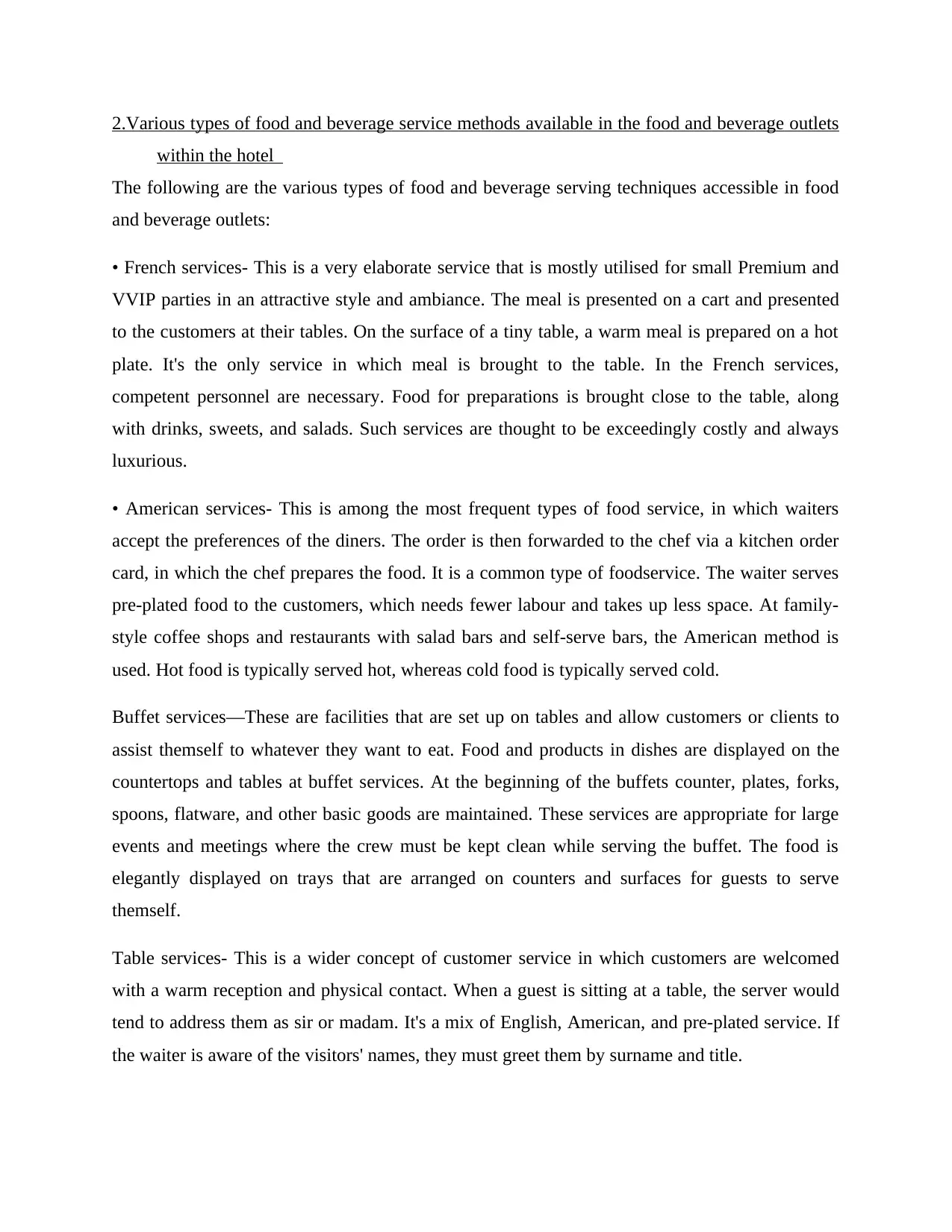
2.Various types of food and beverage service methods available in the food and beverage outlets
within the hotel
The following are the various types of food and beverage serving techniques accessible in food
and beverage outlets:
• French services- This is a very elaborate service that is mostly utilised for small Premium and
VVIP parties in an attractive style and ambiance. The meal is presented on a cart and presented
to the customers at their tables. On the surface of a tiny table, a warm meal is prepared on a hot
plate. It's the only service in which meal is brought to the table. In the French services,
competent personnel are necessary. Food for preparations is brought close to the table, along
with drinks, sweets, and salads. Such services are thought to be exceedingly costly and always
luxurious.
• American services- This is among the most frequent types of food service, in which waiters
accept the preferences of the diners. The order is then forwarded to the chef via a kitchen order
card, in which the chef prepares the food. It is a common type of foodservice. The waiter serves
pre-plated food to the customers, which needs fewer labour and takes up less space. At family-
style coffee shops and restaurants with salad bars and self-serve bars, the American method is
used. Hot food is typically served hot, whereas cold food is typically served cold.
Buffet services—These are facilities that are set up on tables and allow customers or clients to
assist themself to whatever they want to eat. Food and products in dishes are displayed on the
countertops and tables at buffet services. At the beginning of the buffets counter, plates, forks,
spoons, flatware, and other basic goods are maintained. These services are appropriate for large
events and meetings where the crew must be kept clean while serving the buffet. The food is
elegantly displayed on trays that are arranged on counters and surfaces for guests to serve
themself.
Table services- This is a wider concept of customer service in which customers are welcomed
with a warm reception and physical contact. When a guest is sitting at a table, the server would
tend to address them as sir or madam. It's a mix of English, American, and pre-plated service. If
the waiter is aware of the visitors' names, they must greet them by surname and title.
within the hotel
The following are the various types of food and beverage serving techniques accessible in food
and beverage outlets:
• French services- This is a very elaborate service that is mostly utilised for small Premium and
VVIP parties in an attractive style and ambiance. The meal is presented on a cart and presented
to the customers at their tables. On the surface of a tiny table, a warm meal is prepared on a hot
plate. It's the only service in which meal is brought to the table. In the French services,
competent personnel are necessary. Food for preparations is brought close to the table, along
with drinks, sweets, and salads. Such services are thought to be exceedingly costly and always
luxurious.
• American services- This is among the most frequent types of food service, in which waiters
accept the preferences of the diners. The order is then forwarded to the chef via a kitchen order
card, in which the chef prepares the food. It is a common type of foodservice. The waiter serves
pre-plated food to the customers, which needs fewer labour and takes up less space. At family-
style coffee shops and restaurants with salad bars and self-serve bars, the American method is
used. Hot food is typically served hot, whereas cold food is typically served cold.
Buffet services—These are facilities that are set up on tables and allow customers or clients to
assist themself to whatever they want to eat. Food and products in dishes are displayed on the
countertops and tables at buffet services. At the beginning of the buffets counter, plates, forks,
spoons, flatware, and other basic goods are maintained. These services are appropriate for large
events and meetings where the crew must be kept clean while serving the buffet. The food is
elegantly displayed on trays that are arranged on counters and surfaces for guests to serve
themself.
Table services- This is a wider concept of customer service in which customers are welcomed
with a warm reception and physical contact. When a guest is sitting at a table, the server would
tend to address them as sir or madam. It's a mix of English, American, and pre-plated service. If
the waiter is aware of the visitors' names, they must greet them by surname and title.
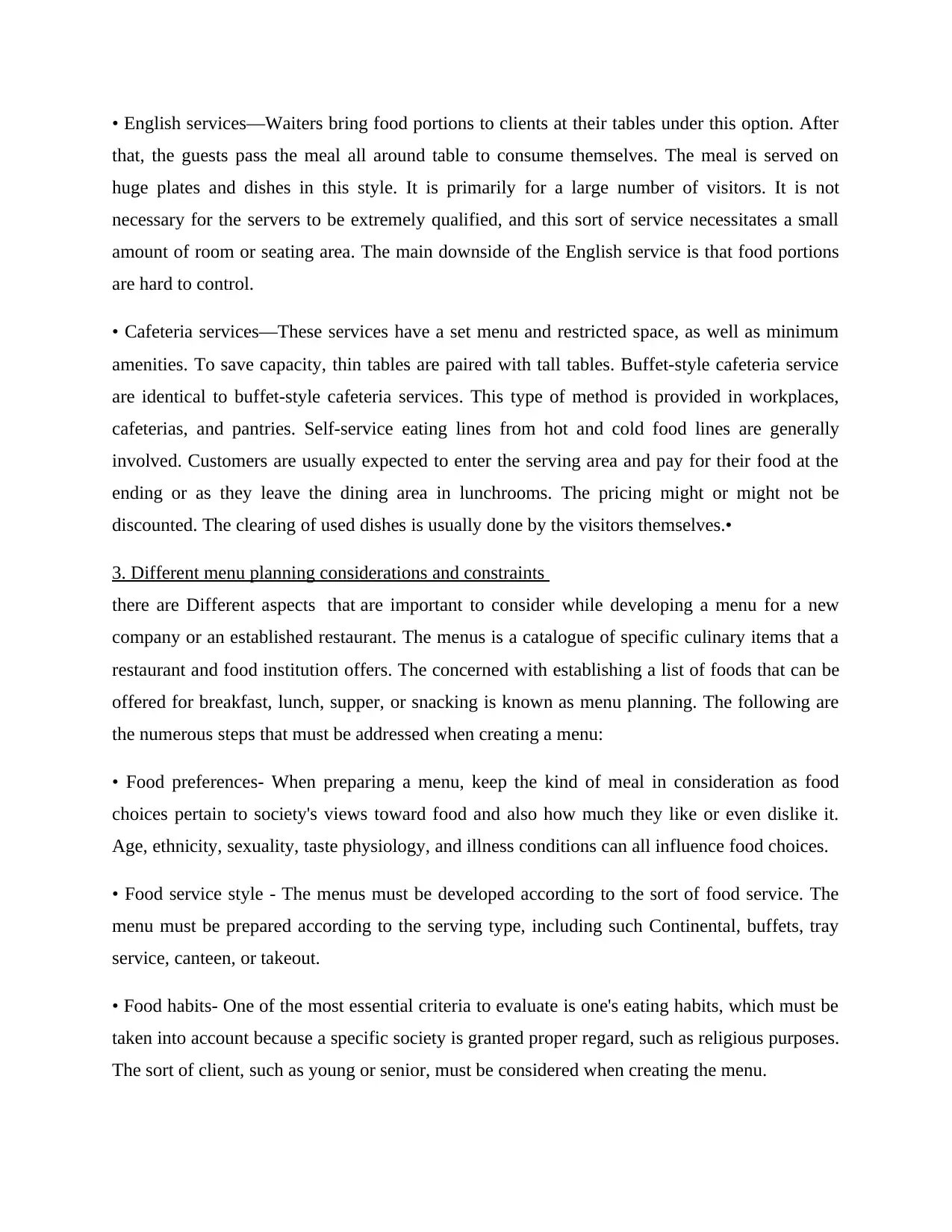
• English services—Waiters bring food portions to clients at their tables under this option. After
that, the guests pass the meal all around table to consume themselves. The meal is served on
huge plates and dishes in this style. It is primarily for a large number of visitors. It is not
necessary for the servers to be extremely qualified, and this sort of service necessitates a small
amount of room or seating area. The main downside of the English service is that food portions
are hard to control.
• Cafeteria services—These services have a set menu and restricted space, as well as minimum
amenities. To save capacity, thin tables are paired with tall tables. Buffet-style cafeteria service
are identical to buffet-style cafeteria services. This type of method is provided in workplaces,
cafeterias, and pantries. Self-service eating lines from hot and cold food lines are generally
involved. Customers are usually expected to enter the serving area and pay for their food at the
ending or as they leave the dining area in lunchrooms. The pricing might or might not be
discounted. The clearing of used dishes is usually done by the visitors themselves.•
3. Different menu planning considerations and constraints
there are Different aspects that are important to consider while developing a menu for a new
company or an established restaurant. The menus is a catalogue of specific culinary items that a
restaurant and food institution offers. The concerned with establishing a list of foods that can be
offered for breakfast, lunch, supper, or snacking is known as menu planning. The following are
the numerous steps that must be addressed when creating a menu:
• Food preferences- When preparing a menu, keep the kind of meal in consideration as food
choices pertain to society's views toward food and also how much they like or even dislike it.
Age, ethnicity, sexuality, taste physiology, and illness conditions can all influence food choices.
• Food service style - The menus must be developed according to the sort of food service. The
menu must be prepared according to the serving type, including such Continental, buffets, tray
service, canteen, or takeout.
• Food habits- One of the most essential criteria to evaluate is one's eating habits, which must be
taken into account because a specific society is granted proper regard, such as religious purposes.
The sort of client, such as young or senior, must be considered when creating the menu.
that, the guests pass the meal all around table to consume themselves. The meal is served on
huge plates and dishes in this style. It is primarily for a large number of visitors. It is not
necessary for the servers to be extremely qualified, and this sort of service necessitates a small
amount of room or seating area. The main downside of the English service is that food portions
are hard to control.
• Cafeteria services—These services have a set menu and restricted space, as well as minimum
amenities. To save capacity, thin tables are paired with tall tables. Buffet-style cafeteria service
are identical to buffet-style cafeteria services. This type of method is provided in workplaces,
cafeterias, and pantries. Self-service eating lines from hot and cold food lines are generally
involved. Customers are usually expected to enter the serving area and pay for their food at the
ending or as they leave the dining area in lunchrooms. The pricing might or might not be
discounted. The clearing of used dishes is usually done by the visitors themselves.•
3. Different menu planning considerations and constraints
there are Different aspects that are important to consider while developing a menu for a new
company or an established restaurant. The menus is a catalogue of specific culinary items that a
restaurant and food institution offers. The concerned with establishing a list of foods that can be
offered for breakfast, lunch, supper, or snacking is known as menu planning. The following are
the numerous steps that must be addressed when creating a menu:
• Food preferences- When preparing a menu, keep the kind of meal in consideration as food
choices pertain to society's views toward food and also how much they like or even dislike it.
Age, ethnicity, sexuality, taste physiology, and illness conditions can all influence food choices.
• Food service style - The menus must be developed according to the sort of food service. The
menu must be prepared according to the serving type, including such Continental, buffets, tray
service, canteen, or takeout.
• Food habits- One of the most essential criteria to evaluate is one's eating habits, which must be
taken into account because a specific society is granted proper regard, such as religious purposes.
The sort of client, such as young or senior, must be considered when creating the menu.
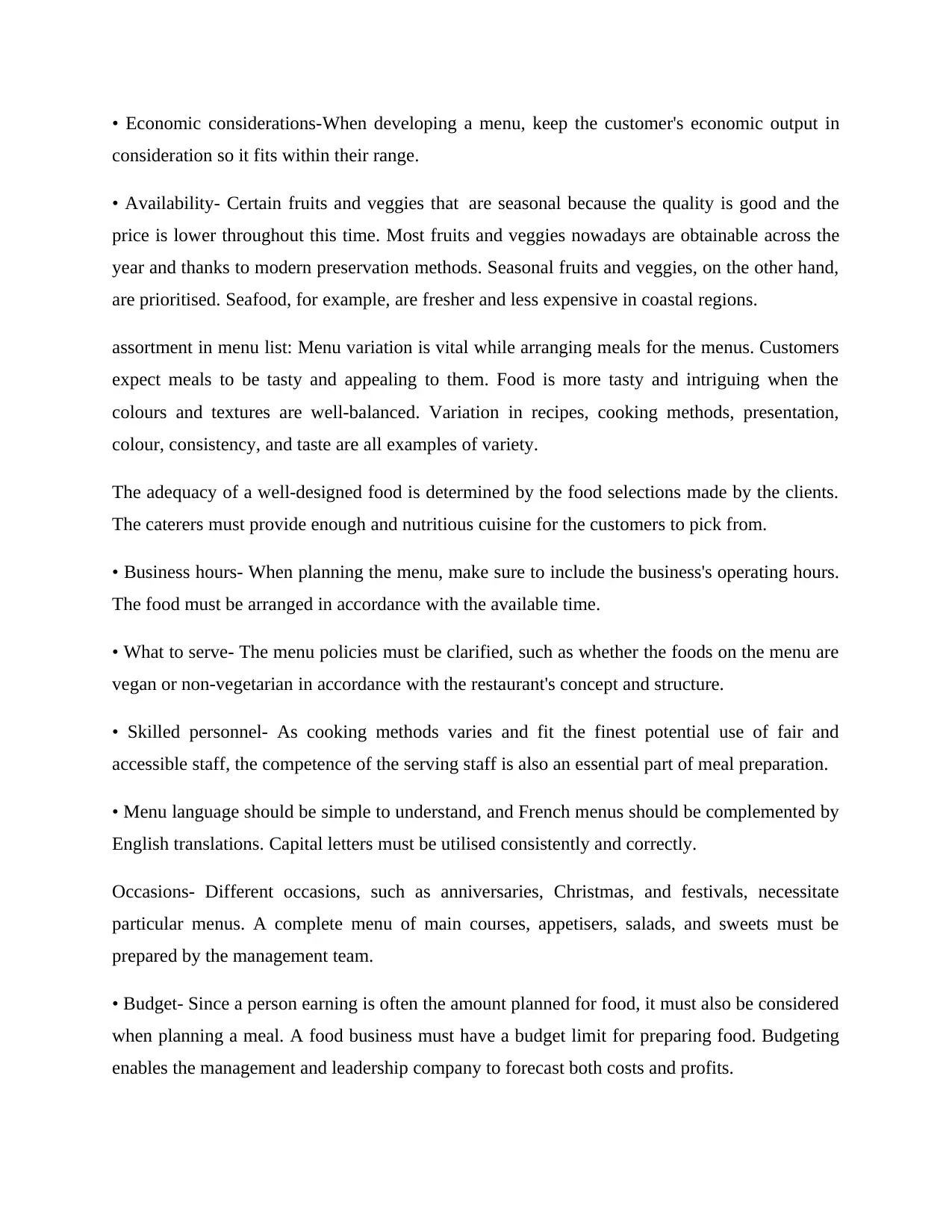
• Economic considerations-When developing a menu, keep the customer's economic output in
consideration so it fits within their range.
• Availability- Certain fruits and veggies that are seasonal because the quality is good and the
price is lower throughout this time. Most fruits and veggies nowadays are obtainable across the
year and thanks to modern preservation methods. Seasonal fruits and veggies, on the other hand,
are prioritised. Seafood, for example, are fresher and less expensive in coastal regions.
assortment in menu list: Menu variation is vital while arranging meals for the menus. Customers
expect meals to be tasty and appealing to them. Food is more tasty and intriguing when the
colours and textures are well-balanced. Variation in recipes, cooking methods, presentation,
colour, consistency, and taste are all examples of variety.
The adequacy of a well-designed food is determined by the food selections made by the clients.
The caterers must provide enough and nutritious cuisine for the customers to pick from.
• Business hours- When planning the menu, make sure to include the business's operating hours.
The food must be arranged in accordance with the available time.
• What to serve- The menu policies must be clarified, such as whether the foods on the menu are
vegan or non-vegetarian in accordance with the restaurant's concept and structure.
• Skilled personnel- As cooking methods varies and fit the finest potential use of fair and
accessible staff, the competence of the serving staff is also an essential part of meal preparation.
• Menu language should be simple to understand, and French menus should be complemented by
English translations. Capital letters must be utilised consistently and correctly.
Occasions- Different occasions, such as anniversaries, Christmas, and festivals, necessitate
particular menus. A complete menu of main courses, appetisers, salads, and sweets must be
prepared by the management team.
• Budget- Since a person earning is often the amount planned for food, it must also be considered
when planning a meal. A food business must have a budget limit for preparing food. Budgeting
enables the management and leadership company to forecast both costs and profits.
consideration so it fits within their range.
• Availability- Certain fruits and veggies that are seasonal because the quality is good and the
price is lower throughout this time. Most fruits and veggies nowadays are obtainable across the
year and thanks to modern preservation methods. Seasonal fruits and veggies, on the other hand,
are prioritised. Seafood, for example, are fresher and less expensive in coastal regions.
assortment in menu list: Menu variation is vital while arranging meals for the menus. Customers
expect meals to be tasty and appealing to them. Food is more tasty and intriguing when the
colours and textures are well-balanced. Variation in recipes, cooking methods, presentation,
colour, consistency, and taste are all examples of variety.
The adequacy of a well-designed food is determined by the food selections made by the clients.
The caterers must provide enough and nutritious cuisine for the customers to pick from.
• Business hours- When planning the menu, make sure to include the business's operating hours.
The food must be arranged in accordance with the available time.
• What to serve- The menu policies must be clarified, such as whether the foods on the menu are
vegan or non-vegetarian in accordance with the restaurant's concept and structure.
• Skilled personnel- As cooking methods varies and fit the finest potential use of fair and
accessible staff, the competence of the serving staff is also an essential part of meal preparation.
• Menu language should be simple to understand, and French menus should be complemented by
English translations. Capital letters must be utilised consistently and correctly.
Occasions- Different occasions, such as anniversaries, Christmas, and festivals, necessitate
particular menus. A complete menu of main courses, appetisers, salads, and sweets must be
prepared by the management team.
• Budget- Since a person earning is often the amount planned for food, it must also be considered
when planning a meal. A food business must have a budget limit for preparing food. Budgeting
enables the management and leadership company to forecast both costs and profits.
Paraphrase This Document
Need a fresh take? Get an instant paraphrase of this document with our AI Paraphraser

4.Sustainable menu planning to be in the competitive market
Sustainable planning assists businesses in making decisions that lessen their social and
environmental effect while reaching a new generation of customers who are growing more picky
and sensitive regarding their food choices. As stated below, there are several strategies to build a
sustainable restaurant menu.
• In-house production- Dividing the cafe and menu items from other businesses in the area by
turning green can help in making the menu more viable. Vegetable from in-house production can
be utilised to produce their own salads with organic produce. The foods will have a flavour that
is both natural and handmade.
• Planet saver- To get a positive impact on the environment by reducing waste and embracing
viable energy-saving methodologies that are beneficial to the planet.
• Plant an on-site garden. Possessing an on-site garden reduces the amount of money spent on
food.
• Reduce food waste- When portion sizes are lowered, food waste can be reduced. It can be
applied by completing a food inspection and asking staff and management to segregate consumer
waste, kitchen waste, rotten food, and other items to reduce waste. Food waste occurs at
numerous stages, thus it must be minimized.
• Buy in bulk- Whenever it comes to durability, materials must be bought in bulk in addition to
making the most of them and conserve them. When components are bought in bulk, there are
fewer emissions involved with obtaining the food delivered.
• Garden programs—Restaurants can collaborate with and spread to different farm and garden
populations. The menu can be prepared using products from the community garden.
• Environmental commitment- The company must follow different waste habits in order to limit
its environmental impact. Implementing sustainability methods like using reusable packaging to
cut waste, recycling training, and use of reused cups and silverware to encourage renewable
content are just a few examples.
Sustainable planning assists businesses in making decisions that lessen their social and
environmental effect while reaching a new generation of customers who are growing more picky
and sensitive regarding their food choices. As stated below, there are several strategies to build a
sustainable restaurant menu.
• In-house production- Dividing the cafe and menu items from other businesses in the area by
turning green can help in making the menu more viable. Vegetable from in-house production can
be utilised to produce their own salads with organic produce. The foods will have a flavour that
is both natural and handmade.
• Planet saver- To get a positive impact on the environment by reducing waste and embracing
viable energy-saving methodologies that are beneficial to the planet.
• Plant an on-site garden. Possessing an on-site garden reduces the amount of money spent on
food.
• Reduce food waste- When portion sizes are lowered, food waste can be reduced. It can be
applied by completing a food inspection and asking staff and management to segregate consumer
waste, kitchen waste, rotten food, and other items to reduce waste. Food waste occurs at
numerous stages, thus it must be minimized.
• Buy in bulk- Whenever it comes to durability, materials must be bought in bulk in addition to
making the most of them and conserve them. When components are bought in bulk, there are
fewer emissions involved with obtaining the food delivered.
• Garden programs—Restaurants can collaborate with and spread to different farm and garden
populations. The menu can be prepared using products from the community garden.
• Environmental commitment- The company must follow different waste habits in order to limit
its environmental impact. Implementing sustainability methods like using reusable packaging to
cut waste, recycling training, and use of reused cups and silverware to encourage renewable
content are just a few examples.
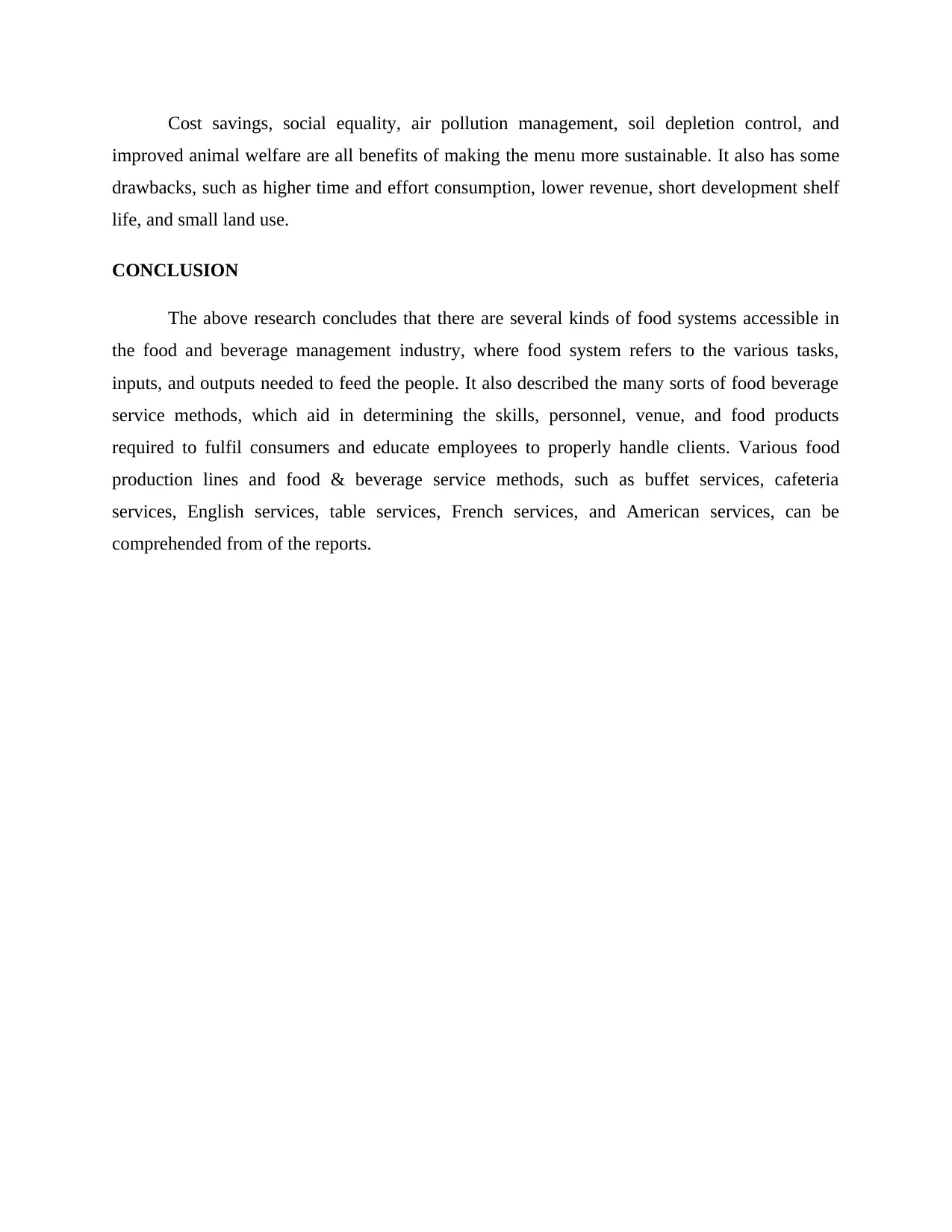
Cost savings, social equality, air pollution management, soil depletion control, and
improved animal welfare are all benefits of making the menu more sustainable. It also has some
drawbacks, such as higher time and effort consumption, lower revenue, short development shelf
life, and small land use.
CONCLUSION
The above research concludes that there are several kinds of food systems accessible in
the food and beverage management industry, where food system refers to the various tasks,
inputs, and outputs needed to feed the people. It also described the many sorts of food beverage
service methods, which aid in determining the skills, personnel, venue, and food products
required to fulfil consumers and educate employees to properly handle clients. Various food
production lines and food & beverage service methods, such as buffet services, cafeteria
services, English services, table services, French services, and American services, can be
comprehended from of the reports.
improved animal welfare are all benefits of making the menu more sustainable. It also has some
drawbacks, such as higher time and effort consumption, lower revenue, short development shelf
life, and small land use.
CONCLUSION
The above research concludes that there are several kinds of food systems accessible in
the food and beverage management industry, where food system refers to the various tasks,
inputs, and outputs needed to feed the people. It also described the many sorts of food beverage
service methods, which aid in determining the skills, personnel, venue, and food products
required to fulfil consumers and educate employees to properly handle clients. Various food
production lines and food & beverage service methods, such as buffet services, cafeteria
services, English services, table services, French services, and American services, can be
comprehended from of the reports.
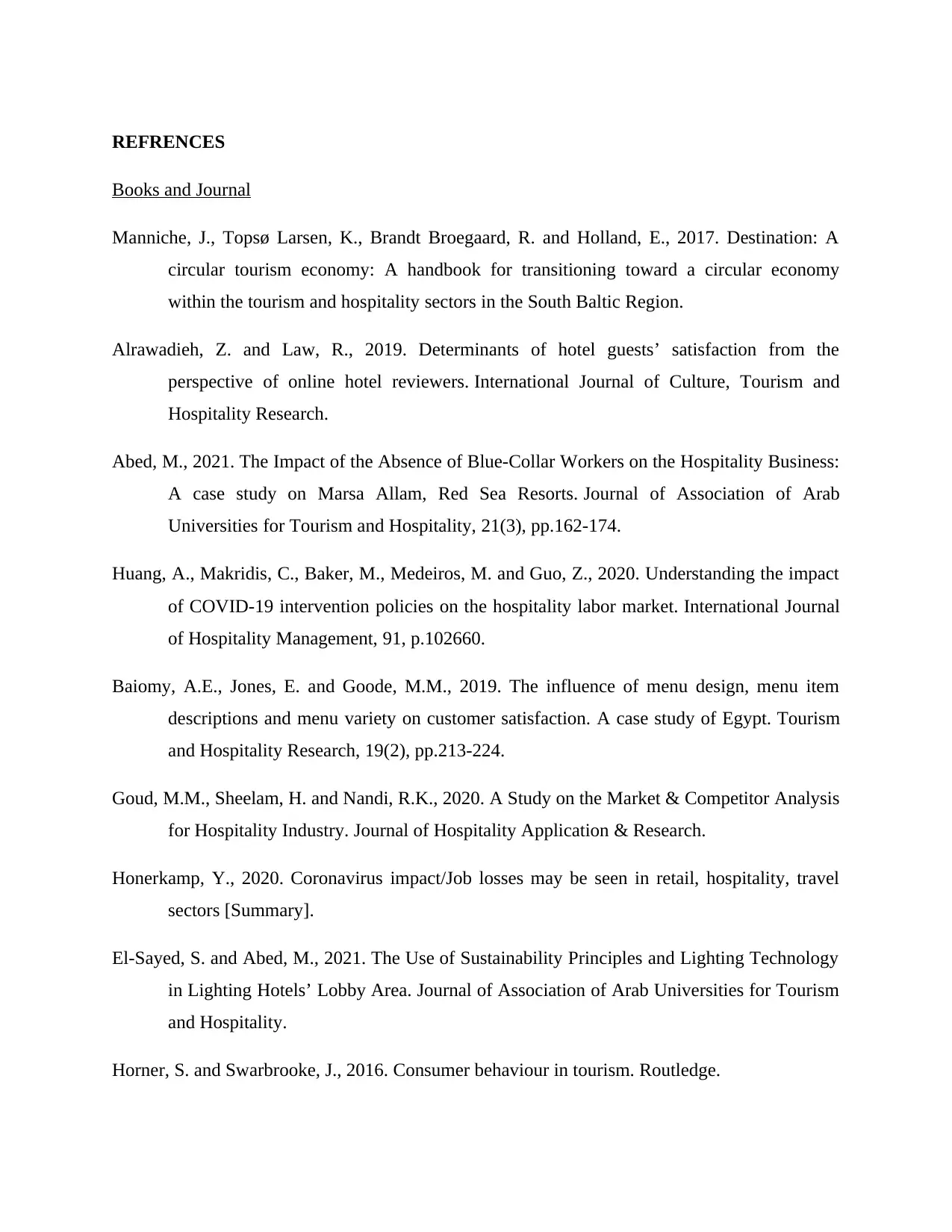
REFRENCES
Books and Journal
Manniche, J., Topsø Larsen, K., Brandt Broegaard, R. and Holland, E., 2017. Destination: A
circular tourism economy: A handbook for transitioning toward a circular economy
within the tourism and hospitality sectors in the South Baltic Region.
Alrawadieh, Z. and Law, R., 2019. Determinants of hotel guests’ satisfaction from the
perspective of online hotel reviewers. International Journal of Culture, Tourism and
Hospitality Research.
Abed, M., 2021. The Impact of the Absence of Blue-Collar Workers on the Hospitality Business:
A case study on Marsa Allam, Red Sea Resorts. Journal of Association of Arab
Universities for Tourism and Hospitality, 21(3), pp.162-174.
Huang, A., Makridis, C., Baker, M., Medeiros, M. and Guo, Z., 2020. Understanding the impact
of COVID-19 intervention policies on the hospitality labor market. International Journal
of Hospitality Management, 91, p.102660.
Baiomy, A.E., Jones, E. and Goode, M.M., 2019. The influence of menu design, menu item
descriptions and menu variety on customer satisfaction. A case study of Egypt. Tourism
and Hospitality Research, 19(2), pp.213-224.
Goud, M.M., Sheelam, H. and Nandi, R.K., 2020. A Study on the Market & Competitor Analysis
for Hospitality Industry. Journal of Hospitality Application & Research.
Honerkamp, Y., 2020. Coronavirus impact/Job losses may be seen in retail, hospitality, travel
sectors [Summary].
El-Sayed, S. and Abed, M., 2021. The Use of Sustainability Principles and Lighting Technology
in Lighting Hotels’ Lobby Area. Journal of Association of Arab Universities for Tourism
and Hospitality.
Horner, S. and Swarbrooke, J., 2016. Consumer behaviour in tourism. Routledge.
Books and Journal
Manniche, J., Topsø Larsen, K., Brandt Broegaard, R. and Holland, E., 2017. Destination: A
circular tourism economy: A handbook for transitioning toward a circular economy
within the tourism and hospitality sectors in the South Baltic Region.
Alrawadieh, Z. and Law, R., 2019. Determinants of hotel guests’ satisfaction from the
perspective of online hotel reviewers. International Journal of Culture, Tourism and
Hospitality Research.
Abed, M., 2021. The Impact of the Absence of Blue-Collar Workers on the Hospitality Business:
A case study on Marsa Allam, Red Sea Resorts. Journal of Association of Arab
Universities for Tourism and Hospitality, 21(3), pp.162-174.
Huang, A., Makridis, C., Baker, M., Medeiros, M. and Guo, Z., 2020. Understanding the impact
of COVID-19 intervention policies on the hospitality labor market. International Journal
of Hospitality Management, 91, p.102660.
Baiomy, A.E., Jones, E. and Goode, M.M., 2019. The influence of menu design, menu item
descriptions and menu variety on customer satisfaction. A case study of Egypt. Tourism
and Hospitality Research, 19(2), pp.213-224.
Goud, M.M., Sheelam, H. and Nandi, R.K., 2020. A Study on the Market & Competitor Analysis
for Hospitality Industry. Journal of Hospitality Application & Research.
Honerkamp, Y., 2020. Coronavirus impact/Job losses may be seen in retail, hospitality, travel
sectors [Summary].
El-Sayed, S. and Abed, M., 2021. The Use of Sustainability Principles and Lighting Technology
in Lighting Hotels’ Lobby Area. Journal of Association of Arab Universities for Tourism
and Hospitality.
Horner, S. and Swarbrooke, J., 2016. Consumer behaviour in tourism. Routledge.
Secure Best Marks with AI Grader
Need help grading? Try our AI Grader for instant feedback on your assignments.

Kang, K.H., Lee, S. and Yoo, C., 2016. The effect of national culture on corporate social
responsibility in the hospitality industry. International Journal of Contemporary
Hospitality Management.
responsibility in the hospitality industry. International Journal of Contemporary
Hospitality Management.
1 out of 11
Related Documents
Your All-in-One AI-Powered Toolkit for Academic Success.
+13062052269
info@desklib.com
Available 24*7 on WhatsApp / Email
![[object Object]](/_next/static/media/star-bottom.7253800d.svg)
Unlock your academic potential
© 2024 | Zucol Services PVT LTD | All rights reserved.




